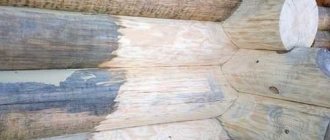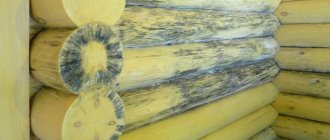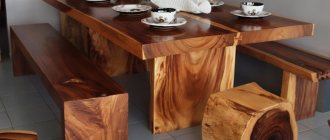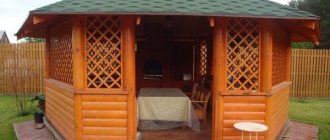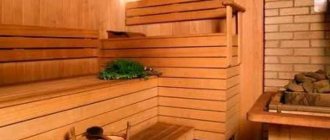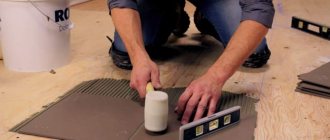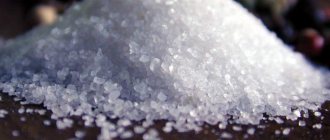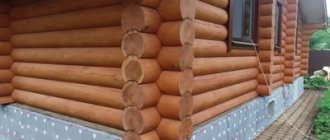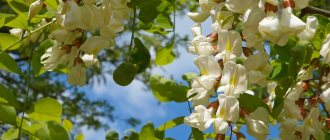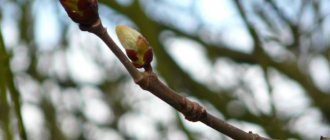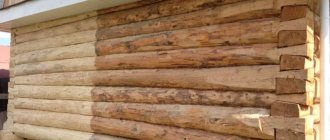It is not enough to design and build a beautiful and durable house made of wood; it is necessary to protect it from a common and difficult problem - mold. It grows quickly and destroys timber, logs, boards, cladding elements and carved decor. It is necessary to take timely and effective measures to combat the fungus, don’t you agree?
For zealous owners, we have collected and presented all the effective ways to exterminate the fungus and stop its spread. Here you will learn how to remove mold from wooden surfaces and what to do to permanently destroy fungal colonies.
We offer you to get acquainted with folk remedies and factory-produced household chemicals, and describe in detail the technology for using the compositions. Useful information is complemented by illustrations, step-by-step photo instructions and video tips.
The diverse and dangerous world of mold
The first signal that there is mold in the house is a change in the color of wooden surfaces, the appearance of characteristic blue, brown, pink and whitish spots, gray stains and a moistened surface. Some fungi do not destroy the texture and do not penetrate deep into the wood, but they spoil the appearance of wooden wall cladding, floorboards, and ceiling trim.
Not only in country houses built from rounded logs or timber, but also in city apartments with a poorly adjusted ventilation system or drafts, mold appears. For example, on the lining, which is often used to decorate a balcony or loggia, unpleasant dark spots may appear.
Colonies of black mold appear on boards much less often than on stone, brick or tile grout, and blue mold is a frequent guest in houses made of timber.
If during the construction of a house the timber or log was not treated with antiseptic impregnation, pale ink stains of mold, called “blue”, will soon appear on the wooden surface.
Fungi like the very common blue fungus completely change the color of wood. They feed on protein, starch, sugar and grow quite quickly - a spot can double in size in just 10 days. But for this, one condition is necessary - the moisture content of the wood is higher than normal.
Blue is not believed to affect strength characteristics, so spore-contaminated timber and lumber are often tested for suitability, and mold may be present in a batch of lumber intended for renovation work.
The most dangerous fungus for wood is putrefactive fungus. It feeds on the fibers of the material, breaking them down with secreted enzymes. First, bright brown spots appear on the surface of boards and logs, and after a few weeks or months the wooden elements become unusable.
At the initial stage, you can still get rid of the fungus by cutting and thoroughly polishing the surface (if possible), but if the mold penetrates deep into the board or log, you can no longer save it
Sometimes the process of development of the hearth occurs secretly: several subtle stains appear on the upper part, but active destruction occurs inside. “Sick” parts of the cladding or frame can be recognized by a dull knock. A durable-looking timber, affected by rot, breaks when pressed.
Mold is harmful not only to the wood itself, but also to people who inhale air contaminated with spores. If there are allergy sufferers in the house, they will always feel unwell when outbreaks occur. Small fungi are also dangerous for healthy people - they can provoke the occurrence or exacerbation of various diseases of the respiratory system.
Image gallery
Photo from
The appearance of blue mold on a new log house
Result of lack of ventilation
The result of using non-galvanized fasteners
Lack of waterproofing in baths and toilets
The most vulnerable and susceptible to mold in a wooden house is the bathroom or combined toilet. The shower room suffers in the same way, even if the box is perfectly sealed and does not allow drops of water to pass through.
Therefore, when installing hygienic rooms in buildings made of timber or logs, it is imperative to follow the technologies for their organization and use protective antiseptic agents.
How does it affect wooden surfaces?
Microscopic fungi lead to the destruction of the place where they live. Boards and any wooden furniture are destroyed, and there is no way to hide this afterwards.
You will only have to buy new things, which, of course, is not profitable, since without getting rid of the cause of the fungus in the house, it will also quickly become unusable.
But besides this, it should be understood that fungi are not entirely localized on the surface. They literally fly around the room, which can cause not only allergic reactions in people and animals there, but also, as doctors say, cancer.
Causes of wood destruction
Let's assume that the inside of the house was lined with absolutely healthy boards. However, over time, they also began to turn blue and gradually become covered with ugly stains. What does this come from?
Mold reproduces by spores that are present absolutely everywhere - in the forest, in the fields, on the roads. It is estimated that forest-dwelling species living on living trees cover approximately 40% of the surface area of the trunks and branches of these trees and shrubs. They do not destroy bark and other tissues, but make them more porous.
Spores are easily carried by wind, animals and even shoes. If microorganisms, by any of the listed methods, enter a house where favorable conditions have been created for them, they quickly begin to multiply. The ideal conditions for the existence of mold are high humidity (from 70%) and temperature from +5ºС to +30ºС.
Good ventilation and moderate humidity are two conditions necessary to prevent mold in areas where water is constantly used, such as the bathroom
Wood is just one of the materials on which entire colonies of fungi settle. They can grow on rubble stone, concrete, plaster, paper and even plastic.
Owners of seasonal country houses in central Russia know very well: if you do not regularly heat a wooden house or do not monitor the condition of the basement and foundation, then dark spots will certainly appear in the corners, on the ceiling and even on the furniture.
The same problem threatens cellars and wooden baths if ventilation is not organized in them. Even the interior lining of the clapboard can become infected with fungus and become completely unusable if it does not have the opportunity to ventilate and dry out.
The lack of air circulation also favors the rapid growth of mold colonies. This can be seen in city apartments, where bathrooms are lined with wood panels and ventilation is poor.
If the surface of the panels is not treated with a protective compound, they will soon become covered with a light white or black coating, and over time the cladding will take on a neglected appearance.
Pinotex Base – deep impregnation for the top layer of wood, acts as a primer and antiseptic. Used in combination with decorative products - Pinotex Wood Oil, Pinotex Classic, etc.
Thus, the reasons for the appearance of fungus or mold are the lack of waterproofing, disruptions in ventilation, and high air humidity.
Kinds
The type of mold determines the choice of method that will help you effectively deal with it forever.
Black
Black mold is the most active and fastest growing of all. It usually destroys the surface quickly. There are several strains that cannot be distinguished from each other without special research.
It is very dangerous for humans, as if it enters the body it causes poisoning and allergies. Fighting black mold is quite difficult - it is not susceptible to most folk and chemical preparations.
Xin
Blue is not so dangerous for the human body, but it causes destruction of structures. Affects fresh and old wood, leading to its rotting. Particularly dangerous for load-bearing structures.
Putrefactive fungus
Putrefactive fungus spreads under conditions of high humidity in the room and the presence of external sources of moisture. Antiseptics and home methods can cope with it.
See also
Types of curbs for garden paths and rules for creating a border with your own hands
White
White mold affects not only furniture, but also food. It is easy to deal with, since it is not resistant to aggressive drugs. It does not pose any significant danger to the body.
Traditional methods of getting rid of fungus
When using what are commonly called folk remedies, you need to remember three points:
- their use is often remembered when it is too late and more effective solutions are needed;
- It is difficult to remove overgrown lesions with household solutions, and when they are destroyed there is always a risk of new colonies appearing;
- When getting rid of mold, you need to simultaneously eliminate the causes that gave rise to it.
Let's look at the available products that you can find at home or buy.
Treatment with chlorine bleaches
Stores sell a solution that is traditionally called “Whiteness”. The compositions of different manufacturers may differ, but the main substance does not change - it is sodium hypochloride, a powerful antiseptic and oxidizing agent.
At chemical plants, it is used to disinfect water and various surfaces; in everyday life, it is used to bleach fabrics and disinfect bathrooms.
Do not forget that any products containing chlorine are potentially hazardous to human health. If they enter the respiratory tract, they can cause vomiting, dizziness, and, with increased doses, poisoning, so it is necessary to use protective equipment: mask, gloves, respirator
When using the solution, it is important to determine that it is diluted with water in a ratio of 1:10, but to combat mold, a more powerful antiseptic is needed, so the proportions change to 1:1.
Whiteness is ideal for smooth surfaces such as tiles or hard plastic. Wood has a porous texture, which is very difficult to process, so a chlorine solution is only suitable for removing external signs, stains and stains; it will not save you from deep penetration of fungus.
The concentrated composition is applied in several layers with a paint brush, then washed off with clean water. If the fire is in an inaccessible place (in the attic), the product does not need to be washed off.
Pharmacy antiseptic solutions
Hydrogen peroxide, which is used to treat wounds and scratches, also works great against fungus. As a rule, a small bottle of peroxide can always be found in the first aid kit, so nothing prevents you from doing a little experiment.
Moisten a cotton pad with a few drops of the solution and wipe the mold-affected wooden surface. If the stains disappear, you can process the already clean area several more times.
Like chlorine-containing substances, you don’t need to expect miracles from peroxide. You can use it to clean tiles, porcelain tiles, enameled or concrete surfaces, but wood is a soft material and cannot be quickly “treated”
If you purchased a bottle of 3% solution, do not dilute it with water, this concentration is not considered strong. It is enough to apply peroxide to the damaged area and leave for a while, then repeat the procedure.
The second solution “from the pharmacy” is ammonia, which is included in products for cleaning windows and washing the print heads of inkjet printers. It also works effectively on smooth surfaces (glass, earthenware, plastic), and with moderate success on wood (or plasterboard).
The procedure should be carried out according to the same rules as with “Belizna”: dilute in a 1:1 ratio, do not forget to wear gloves and a respirator.
The use of "kitchen" products
At least two products used to combat mold can be found in your kitchen cabinet. This is vinegar and soda.
Vinegar, like Belizna, is not able to completely remove mold, but, unlike it, it is absolutely safe for humans. It is not diluted with water, but is applied in large quantities to the infected areas using a roller, brush or sponge.
To increase efficiency, do not use weak table solutions, but vinegar essence or acid, which is more concentrated
If the mold on a wooden surface resembles plaque, then there is a chance of getting rid of it completely. However, do not forget about the persistence of harmful microorganisms and wipe the areas at risk every 2 weeks - until you correct the ventilation and insulate the room.
Soda is also one of the safest remedies. It is often used for cleaning children's clothes and washing dishes. However, when paired with vinegar, it can destroy a small colony of mold. If you notice a scattering of small black dots on the walls, dilute baking soda in vinegar and wipe the infected area.
The vinegar-soda solution can be placed in a spray bottle and sprayed on the walls (floor, ceiling, attic floors, exterior of the house) every 2-3 hours.
Soda does not harm wood, so this option is also possible: pour a small amount of powder onto a slightly dampened cloth and rub into the damaged area, and then rinse with water.
Appeal to professionals
Turning to professionals is an expensive procedure, but it will be 100% effective and will rid your home of the harmful effects of pathogenic microorganisms. This is a whole process that requires preparation. It is carried out according to the algorithm:
- identifying the cause;
- restriction of all furniture and structures from contact with other things;
- ensuring optimal climatic conditions for work;
- complete destruction of mechanical fungus;
- chemical treatment;
- drying and restoration measures, if required;
- coating with antiseptic and varnish.
Of course, the scope of work varies depending on the conditions (outdoors or indoors, the size of the surface being treated), and the type of formation.
Professional mold control
There is another effective method for removing an unpleasant “guest” - calling specialists.
They can do things that the residents of the house cannot do on their own:
- will diagnose the microclimate using high-precision instruments;
- analyze the condition of the affected objects;
- will conduct an examination and draw up a conclusion on the nature of the occurrence of mold on wooden surfaces;
- will select the most effective professional products and treat areas of fungal growth with biocides;
- They will neutralize indoor air using UV installations.
If necessary, professionals will carry out construction work: increase the efficiency of ventilation, reduce heat loss by laying insulation, and restore normal humidity by installing waterproofing.
Installing a reliable ventilation system in a wooden house will ensure a normal level of humidity and conditions under which mold cannot develop and destroy the wood.
The main advantage of professional treatment of the room is the guarantee that mold will not bother you in the near future. The most responsible companies undertake to carry out repeated measures to eliminate newly emerging outbreaks.
If you decide to call a team of specialists, take care to document the order. The contract for the provision of services must include a warranty period and indicate a list of procedures performed. If workers carry out construction activities, they must be guided by the requirements of GOST and SanPiN.
First steps when colonies are detected
You need to think about how to get rid of mold immediately after it is discovered. Delay will lead to the fact that it will be almost impossible to cope with the fungus; it will destroy the furniture. The first steps include the following steps:
- creating optimal humidity and temperature;
- providing ventilation;
- eliminating fungus using a knife with a sharp blade or a metal brush;
- burning of purified fungus;
- washing with a detergent solution;
- antiseptic treatment for furniture.
But it should be noted that such actions do not always lead to a positive result. They are only a temporary salvation, since if the mold is firmly ingrained into the surface, then it cannot be dealt with this way.
Rules for storing silver products
For cutlery, buy boxes with compartments lined with soft fabric. Jewelry is stored in a special box. Items should not be piled up; friction will cause scratches on them. In addition, the chain gets tangled and can be broken. It is permissible to put jewelry in separate plastic bags and store it in a common box.
Choose a place for decorations with normal humidity, away from heating devices and direct sunlight.
Basic rules for caring for silver jewelry
Knowing how to clean a silver chain, cutlery, or jewelry with stones, you won’t have any problems removing plaque. But it is easier to prevent discoloration than to fight it. A few recommendations will help maintain the beauty of your accessories:
- jewelry is removed before visiting a bathhouse, sauna, or taking a bath;
- promptly clean products from dust and dirt;
- before using creams and masks, remove the rings;
- wear protective gloves when doing household work - rings and bracelets can easily be scratched with a knife or brush.
Silver accessories do not cause any special trouble. Regular cleaning from darkening, polishing items with oil or preventive treatment with lipstick will help preserve the beauty of brooches, rings and earrings for a very long time.
Preventing food contamination
Who wants to suffer from food poisoning? Follow these simple tips to avoid such problems:
Buy hard acrylic or rubber boards as they are the most hygienic to use (these are the boards commonly used in restaurants). Wooden boards should be disinfected regularly and kept as clean as possible. It is convenient to have several boards for different types of food. You should have at least two of them: one for raw meat and fish, the other for vegetables, bread and any other foods that can be eaten raw. Buy colored sets of cutting boards or label the boards yourself, this will make it much easier to distinguish them by purpose. Throw away any cutting boards that have cracks, large scratches, or obvious signs of dirt.
Like all kitchen utensils, cutting boards have an expiration date and it is important to dispose of them promptly to maintain kitchen hygiene and cleanliness.
Processing cutting boards
Most wooden cutting boards are made from hardwoods such as teak, although bamboo cutting boards are also quite common. Any type of wood should be treated to prevent stains and keep food odors and bacteria from lingering on the surface.
Use an oil that can be used repeatedly, such as food-grade mineral oil.
It is safe and will fill the pores of the wood well. Another name is liquid paraffin, edible petroleum jelly. Rub the oil onto the board and let it soak into the wood. Wipe off excess oil with a clean, dry cloth. Repeat this process at least once a month.
Attention! Do not use vegetable oil on cutting boards. This oil will go rancid and cause an unpleasant odor.
After mineral oil, apply beeswax
, it will make the surface of the board waterproof, which will protect the wood from wear and tear and extend its service life. In a microwave-safe container, microwave 1/2 teaspoon (2.5 ml) beeswax with 1 cup (240 ml) mineral oil for about 45 seconds. Apply warm wax to cutting board. Based on materials from www.cleanipedia.com, ru.wikihow.com
Wooden kitchen cutting boards have many advantages compared to their plastic and ceramic counterparts. Products do not slip on their surface, allowing you to cut them much more confidently and quickly. In addition, dense wood, in addition to its environmental friendliness, is also famous for its durability, so wooden boards last much longer than their other analogues.
But wooden cutting boards have their drawbacks. The main ones are the ability of wood to absorb odors and change its appearance for the worse. In order for the board to last longer, it is necessary to properly care for it. I hope now you know how to do it :o)….
Over time, kitchen boards absorb odors, and this problem can no longer be solved by simply washing. It’s not very pleasant to cook on such a household item, but you shouldn’t throw it away right away, since cutting boards in the kitchen can be cleaned effectively and in a short time.
Prevention
It is recommended to take the following preventive measures against the appearance of fungus:
- Regularly check air ducts, hoods, and ventilation.
- Make it a rule to remove excess moisture immediately, and not wait “until it dries on its own.”
- Ventilate and heat living spaces.
- Monitor the level of humidity in the house, do not create “greenhouse conditions” - high levels of moisture and heat.
- Once a week, treat suspected areas of mold with special chemicals or traditional methods. Especially if measures were taken to get rid of the fungus.
These simple tips will help protect your home from uninvited “guests” and maintain the health of all family members.
Even if you have done everything possible to get rid of mold, it can return if the root cause is not removed.
- Try to avoid high humidity in the apartment. In addition to hoods, in the cold season you will need an air conditioner to dry the air. In addition, ventilate the room more often.
- Insulate the windows and maintain the same temperature in the house. Remember that due to its changes, it creates a microclimate favorable for the proliferation of dangerous airborne spores.
- Clear out cluttered rooms, clean out the closet, dismantle the mezzanines so that the air in the rooms can circulate freely.
- In addition, do not overwater the flowers. Constantly standing water in trays can also cause mold to form.
- In the bathroom, try to dry the shower curtain as often as possible; do not roll it up when it is wet.
- If moisture constantly accumulates on the walls or ceiling, you should think about insulating your home.
- Constantly wipe the interior of the furniture and let it dry thoroughly. Of course, regular cleaning of the entire house will be the best prevention.
Video “Choosing an antiseptic”
From the video you will learn how to choose an antiseptic for wood processing.
Number of blocks: 25 | Total number of characters: 25258Number of donors used: 6Information for each donor:
- https://plesneveet.ru/pleseni/plesen-na-derevyannyh-poverhnostyah/kak-ubrat-chernuyu-plesen-na-doskah/: 1 blocks out of 3 used, number of characters 747 (3%)
- https://serviceyard.net/sovetyi/kak-ubrat-plesen-s-derevyannyih-poverhnostey.html: 4 blocks out of 6 used, number of characters 4858 (19%)
- https://dombrat.ru/uborka/kak-ubrat-plesen-s-derevyannyh-poverhnostej.html: 6 blocks out of 7 were used, number of characters 6757 (27%)
- https://parazit.guru/plesen/kak-ubrat-plesen-s-derevyannyh-poverhnostej-4439/: 9 blocks out of 12 were used, number of characters 5240 (21%)
- https://derevo-s.ru/material/zashita/obrabotka-drevesiny-ot-gribka-i-pleseni: 2 blocks out of 4 used, number of characters 5002 (20%)
- https://kliningovyj-raj.ru/sanobrabotka/kak-ubrat-plesen-s-derevannyh-poverhnostej/: 3 blocks out of 5 were used, number of characters 2654 (11%)
Mold on boards is a common occurrence, which, however, requires radical measures. It won’t be difficult to remove mold just once: it can be easily cleaned off. However, it is already difficult to achieve lasting protection against reappearance.
There are many products for treating boards against fungus, but it is best not to use any specific product, but to combine several. It is necessary to treat lumber with different means at intervals: today one means, after a few days another.
Overview of the antiseptic products market
When folk remedies are useless, heavy artillery enters the battle - highly effective chemical solutions that are used both for prevention (initial treatment) and for “treating” already damaged elements. Let's look at the popular antiseptics that can be found on the shelves of construction supermarkets.
Most of the products presented by modern manufacturers are universal. Their composition is such that it simultaneously protects the wood from rot, mold, sunlight, bugs and even fire.
Wood for the external cladding of a house, like all elements of decorative interior design, must be processed without fail, otherwise the risk of damage is very high.
Tikkurila Valti - has excellent protective properties even in difficult atmospheric conditions, contains natural oils, and prevents the formation of mold. Volume 2.7 l – 1500 rub.
Let’s name several manufacturers of antiseptics that are popular and regularly occupy the top lines of the ratings:
Tikkurila. Known for a large range of multi-component impregnations that can protect wood in the most difficult conditions. Pay attention to Valtti Pohjuste deep penetration primer, Vinha covering solution. Tinted impregnation-glaze Valtti Color (Extra, Satin, Primer series) penetrates deep into wood fibers and does not form a film, as a result of which wooden products look natural.
Senezh. The most reliable antiseptic is for deep impregnation, ideal for treating facades. It is not washed out with water and is able to protect wood in difficult weather conditions. Senezh Ecobio is designed for use inside the home, and Aquadecor was created specifically for decoration. There are many positive reviews about Senezh protective equipment for saunas and baths.
Belinka. Suitable for processing internal and external wooden surfaces. BELINKA BASE contains a concentrated portion of biocides, BELOCID is suitable for both prevention and treatment of contaminated surfaces
BELINKA IMPREGNANT is a colorless impregnation, good where it is important to preserve the natural texture of the fibers.
Aquatex. Perfectly protects logs, boards, lining, chipboards from mold and wood-boring beetles. Has more than 10 tinted options
The solution is used as a primer or impregnation.
Neomid. A well-known Russian brand with a wide range of antiseptic products. NEOMID 440 ECO effectively protects wood products in rooms with high humidity, NEOMID 400 is used for processing interior parts, NEOMID 46 BiO protects lumber from mold damage.
The list can be continued with the names of alternative products: Dufa Wood Protect, Sitex, Pinotex, Texturol, Woodmaster. When using this or that product, you must act strictly according to the instructions.
Building structures treated with the products are not at risk of premature destruction. Its use guarantees the preservation of load-bearing capacity
In addition to protecting against mold, Minwax Cleaner restores the color and structure of wood used in the construction of furniture.
Antifungal treatment of building materials and structures that come into contact with a humid environment and suffer from atmospheric conditions will eliminate the destructive consequences for wood
The antiseptic formula is designed to combat mold on wood, the composition is absolutely safe for humans and four-legged pets
Whitening products
Bleaching of logs is carried out using special bleaching agents, which are divided into two large groups:
- Chlorine-containing products. These include products containing: sodium or potassium hypochlorite, bleach, chlorine dioxide.
- Compositions without chlorine, in which the active substances are ammonia, hydrogen peroxide, oxalic acid and alkalis.
Any composition for bleaching wood operates on the same principle: it causes an oxidative process, as a result of which the coloring pigment becomes discolored and the fungal molecules are destroyed.
Before treating wood with bleaching agents, the surface must be sanded well. As a result of sanding, up to 20% of the blue stain is removed. In addition, bleach penetrates and is absorbed into the wood structure better if it is applied to sanded boards.
So, the main recommendations:
- after bleaching, any composition must be washed off with water;
- acid-based bleach is washed off with an aqueous solution of soda;
- You cannot combine different compositions; the surface can only be treated with one product.
- if the wood is severely affected by fungus, it is necessary to treat it with a more concentrated composition.
- bleaching is most effective if it is carried out at a temperature of 18-20 degrees Celsius and at a humidity of about 60%;
- When processing wood inside the house, it is necessary to ensure ventilation of the room, because Almost all formulations contain components that are unsafe for health. If the treatment was carried out in a bathhouse, it is necessary to dry-heat the room twice before taking bath procedures to remove chlorine fumes.
Below you will learn how to whiten a log house after sanding.
Disinfection
From time to time it is necessary to disinfect the cutting surface, and special attention should be paid to this process. If you are thinking about how to remove odors and food residues, weigh all the pros and cons of each method
The “thermonuclear” Soviet version is purification using chlorine. For this purpose, you need to mix five liters of water with one tablespoon of this substance. After this, a wooden board is dipped into the mixture for half an hour. You need to act very carefully, work only with gloves and do not forget about your own safety. After using chlorine on your board, you must thoroughly remove all traces of the chemical using hot water. But no one can guarantee that there are no toxic compounds left in the porous structure of the surface. Since the board is used for cooking, it is still highly undesirable to use this method.
It is better to use regular soda, available to every housewife. To do this, dilute a teaspoon in 0.5 liters of hot water and stir thoroughly. It is enough to keep the board in the solution for 5-10 minutes, then wash it thoroughly and leave it to dry in an upright position. By the way, you can clean a plastic board in the same way, since soda is a universal cleaner for many surfaces.
In addition to alkali, hydrogen peroxide is also suitable for this purpose. To do this, two teaspoons are mixed with 0.5 liters of water, after which a board is placed in the resulting composition. This method helps get rid of odors and food residues.
Traditional methods
If you don’t have any detergents at hand, you can use methods that have helped our grandmothers out more than once.
One great way to remove dirt is lemon. Just half of this citrus is enough to clean a plastic or wooden board from food debris. Rub the surface with lemon, after which the cleaned item is thoroughly washed with water.
Another folk recipe can be a combination of citrus and salt. As in the previous case, the board is rubbed with lemon and then sprinkled with salt. After 10-12 minutes, the surface is again rubbed with half a citrus fruit, and then washed with water.
If you need to remove the smell of herring or meat from the board, vinegar will do the job perfectly - you can wipe the cutting surface with it.
If you notice that the board has cracks or scratches, get rid of it as soon as possible. Even if you really like this thing, remember that if it is deeply damaged, it is no longer suitable for use.
How often do you wipe your cutting board dry after work? Not always, but in vain. This is why black spots of mold form on it. Getting rid of them is not so easy. Boards are made from a variety of materials, but wood and plastic remain the most popular. Does everyone know how to clean a cutting board? We’ll talk about this so that you don’t have any doubts about whether you’re doing everything right or missing something.
